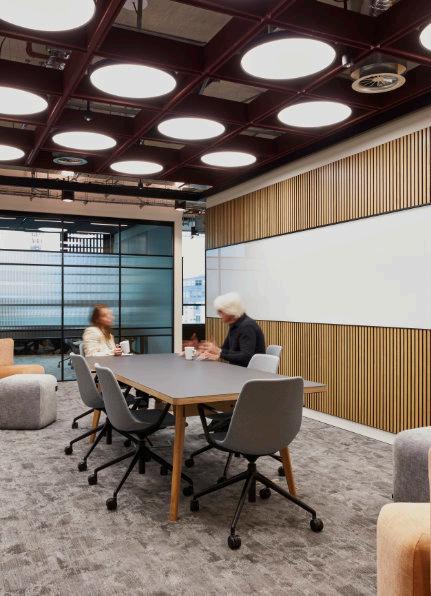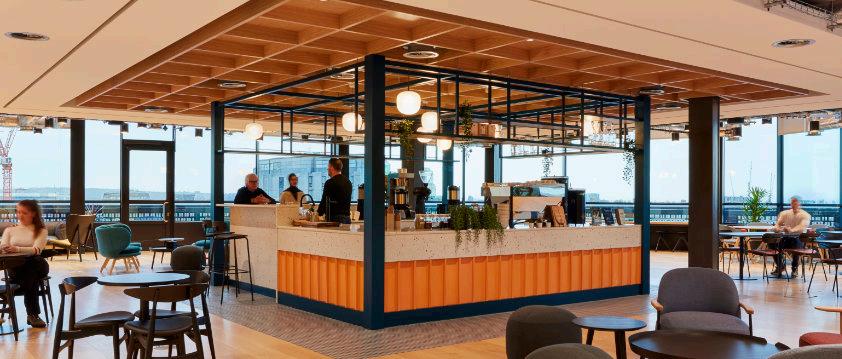





Neuroarchitecture is an emerging discipline that combines insights from neuroscience, environmental psychology, and architecture to understand how the built environment influences the human brain. An approach that aims to design spaces that positively affect emotions, cognition, and behaviours.
In recent years, the relationship between people and their environment has gained increasing attention, particularly in workplace design. Offices are no longer seen as merely functional spaces but are now understood to be pivotal in shaping employee experience. By applying neuroarchitectural principles, we can create working environments that promote health, wellbeing and productivity, fostering more positive outcomes for employees and employers alike.
Read on as we explore some of the key strategies and associated benefits of applying neuroarchitectural principles to workplace design.

Inclusive environments play a crucial role in enabling individuals to thrive. A workplace that fosters a sense of belonging allows employees to bring their whole selves to work, irrespective of background, gender, or abilities.
So how do we create a workplace of belonging? Companies must go beyond compliance and provide tailored support that considers employees’ individual needs. Encouraging diverse perspectives and offering equitable opportunities can drive engagement and innovation.
Workplace inclusion is not solely a design challenge but a cultural one. Supporting employees through different life phases demonstrates an organisation's commitment to its workforce, particularly when addressing challenges that are often overlooked, such as menopause. Increased awareness around menopause in the workplace has highlighted its profound impact on employees, with symptoms like fatigue, reduced concentration, lack of motivation, mental fog, and diminished physical capacity often affecting performance.
These challenges disproportionately affect individuals at the peak of their professional careers with statistics revealing that 25% of women consider leaving their jobs due to menopause, while 14% opt to work part-time, and 10% eventually resign. Addressing these issues is not only a matter of fairness but also a strategic imperative for organisations seeking to retain experienced talent.
Simple measures such as offering rest areas, meditation spaces with manual temperature controls, and flexible working options can significantly enhance employee comfort and wellbeing. These thoughtful adjustments not only help individuals manage their personal needs more effectively but also contribute to higher job satisfaction and retention, fostering a more supportive and inclusive workplace.


Social connections are also important. When the brain has a non-active moment, on a break from work for example, its response is to consider other people’s thoughts, feelings and goals.”
“Neuroscience and employee health and wellbeing” via www.wtwco.com
The pandemic underscored the importance of connection, as remote work left many feeling isolated from their organisations and peers. Offices must now evolve into hubs that foster collaboration and community.
Humans have a natural need to belong. Spaces designed to encourage social interaction, whether around food and drink, shared knowledge hubs, or think tanks, can reinvigorate the workplace culture. Social connections reduce loneliness and increase a sense of purpose and belonging, driving productivity and engagement.
Modern employees are also more selective, prioritising alignment with personal values and social responsibility when choosing employers. Companies that emphasise environmental commitments and community impact are increasingly attractive to the new workforce.
How a space looks, feels, and performs significantly influences employee behaviour. Sensory design, which considers lighting, colour, smell and texture, allows spaces to be tailored for specific needs.
Colour and texture elements evoke powerful emotional responses. For instance, colour therapy can stimulate creativity or calmness, depending on the palette. Meanwhile, tactile materials enhance comfort and engagement.
Careful consideration and balance are essential to avoid overstimulation. The key lies in designing a variety of spaces tailored to different tasks and purposes. Whether it’s calming zones for relaxation, focused areas for deep work, or vibrant spaces for collaboration, a well-thought-out balance ensures that each environment serves its intended purpose without overwhelming the senses.
Nature significantly enhances sensory experiences in the built environment. Incorporating natural materials, greenery, and scents that evoke the outdoors can have profound calming and stress-reducing effects. Exposure to these elements stimulates the release of endorphins, which interact with the brain’s opiate receptors to promote relaxation and wellbeing.
Designing spaces that integrate biophilic principles not only improves mood but also supports mental health and productivity, creating environments that feel restorative and harmonious.


Approximately 1 in 5 individuals are neurodivergent or have neurological conditions which affect how they think, learn and interact with the world.
Recognising neurodiversity in employees, embracing their strengths and individual needs is essential for creating inclusive workplaces. Neurodivergent individuals often excel in lateral thinking, deep focus, problem-solving, and creativity.
Designing environments that support and embrace individual learning and thinking is important. For example, the fit-out of Soho Place in London for a leading quantitativeresearchand technology firm company incorporated a Tuneable Hub; a room that could be fully customised depending on user needs.
Adjustable lighting can cater to diverse tasks, from focusintensive work to relaxation. Warmer lighting is ideal for informal discussions, while cooler tones enhance concentration. Advances in Artificial Intelligence could soon enable lighting to adapt to users’ moods and activities.
In contrast, some spaces have been designed to include minimal colour, texture or light to provide a less stimulating environment as over stimulus in a work environment can increase stress levels. Creating the right balance of customisation and thoughtful design within a working environment is key to reducing stress and improving performance.

Health and wellbeing are deeply connected to physical nourishment and rest. For years sport performance studies have looked at the link between sleep and performance. It is proven that eight hours of sleep a day increases focus, mental agility and motivation. Research shows that sleep deprivation reduces cognitive function, decision-
making ability, and emotional regulation. Not sleeping or getting enough sleep can lower your learning abilities by as much as 40%. Companies can support better health outcomes by encouraging work-life balance and providing spaces where people could have breaks during office hours, increasing productivity.
The WELL Building Standards highlights the importance of healthy eating patterns and access to healthy food. Research shows that fatigue, low energy levels and lack of concentrations is linked to consumption of processed foods.
Healthy eating patterns are shaped by environmental design. Offices that increase access to nutritious food, encourage healthy choices and provide environments to dine away from desks increase performance and productivity as well as fostering a happier and healthier workforce.

Physical activity is crucial for brain health. Exercise increases oxygen flow, reduces inflammation, and promotes the growth of new brain cells, enhancing mood and cognitive skills.
Research has shown that stress can affect brain function. When the brain is subject to prolonged stress, high levels of cortisol are released resulting in a reduction of motivation and mental agility. Designing workplaces with fitness areas, yoga rooms, or active pathways can encourage movement and reduce stress.
Neuroarchitecture offers a framework for designing environments that enhance health, wellbeing, and productivity. By addressing sensory needs, fostering social connections, and recognising diversity, workplaces can evolve into spaces that support individuals holistically. As the understanding of neuroscience deepens, the potential to create meaningful and personalised experiences in the built environment, and within the workplace, becomes limitless.